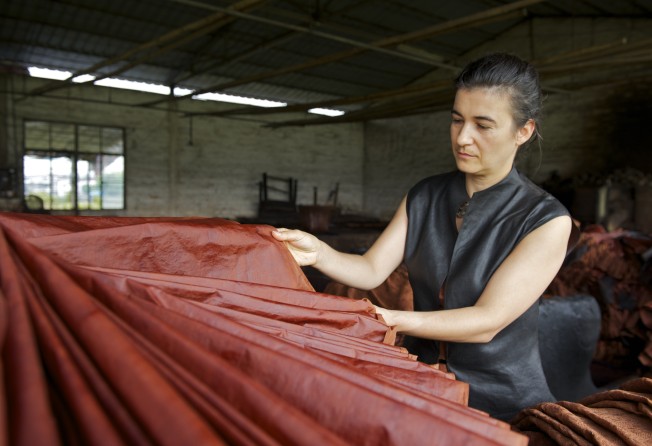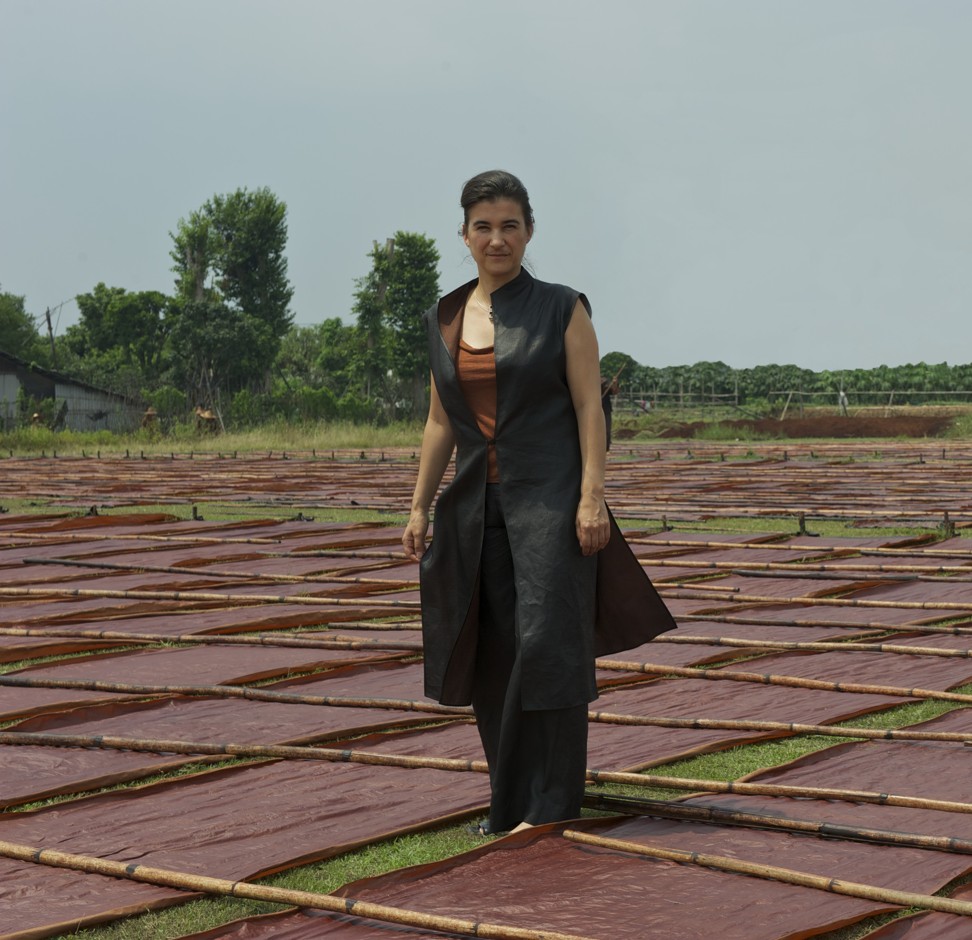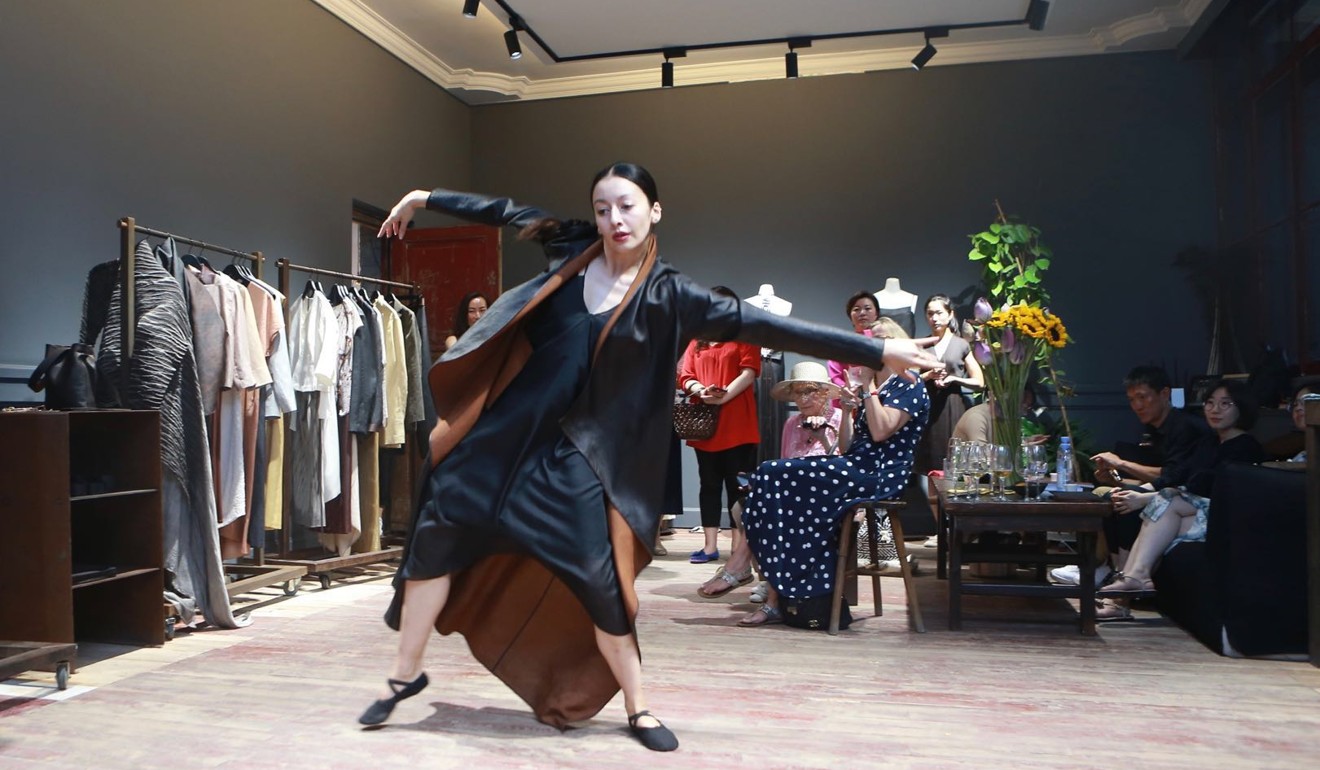
Natural dyes help Beijing-based designer revive an ancient Chinese textile technique
- Tea silk has largely fallen out of use in China. It gets its deep reddish-brown colour from a dye made from a yam native to Guangdong province
- Designer Kathrin von Rechenberg has been using the labour-intensive fabric to craft contemporary Chinese-inspired garments

Traditional Chinese clothing has inspired many designers, but all too often things can veer into tacky costume-drama territory. Kathrin von Rechenberg’s eponymous label, however, avoids obvious chinoiserie while celebrating traditional Chinese textiles and silhouettes through her unique, contemporary creations.
Rechenberg’s evening wear flows like robes from the Han dynasty, while her office-ready jackets and blouses are more structured. There’s even a growing menswear collection that translates traditional Han styles into modern-day couture.
Earthy tones, with splashes of yellow and blue, dominate the label’s Beijing-based studio, thanks to the designer’s signature use of tea silk. One side of the material is a vibrant shade of reddish-brown; the other, a contrasting black.
It is this duality that inspires Rechenberg. “I really can never decide which side is more beautiful,” she says, with a laugh.

Initially introduced to the fabric by a Taiwanese designer, Rechenberg kept coming across tea silk in textile markets from Hong Kong to Beijing. She eventually tracked down the source to the city of Shunde, in China’s southern Guangdong province. Although tea silk had largely fallen out of use in China, there was a healthy export market to Japan and South Korea.
The dye is made from a type of yam native to southern China. While the flesh is a vibrant orange, the rust-coloured shades don’t immediately take root when used in fabric. Instead, the silk must be dyed up to 30 times. In between, it is laid out to dry on a grassy field. The interaction between the sun, grass, and dye gives each piece of fabric a unique characteristic.
The labour-intensive fabric clearly bucks the fast-fashion trend.
Once the tea silk takes on its characteristic ruddy tint, one side will be covered with mud. This sets off a chemical reaction between the iron-rich silt of the Pearl River Delta and tannins in the dye, forming a dark metallic sheen on one side.

The stickiness of the dye protects the original auburn colour of the other side, even where the weave of the fabric is loose. The tea silk is washed a final time in the river and then stored for several years. Like a fine wine, the colours grow bolder with time.
“It’s a living material,” says Rechenberg. “Each wear gives the fabric its own touch; not everybody could wear it [the same way]. It wouldn’t look the same after a few years.”
Rechenberg has a long history of taking forgotten textiles and modernising them. She’d scour the flea markets of her youth in Germany, looking for vintage clothing that could be updated. Though she was curious about how they were constructed, it was more an issue of cost. New clothes were expensive. At heart, she is a practical woman.

She considered careers in bookbinding and millinery, but ultimately settled on fashion design. “Everyone needs clothes,” she says, though she laments the way fast fashion has devalued the industry.
Without government support, even the traditional way of producing tea silk would eventually disappear, she adds. Urbanisation has swallowed nearly all the surrounding land.
After winning high-profile fashion design awards in her native Bavaria, including best tailor in Munich for a graduation project, she landed a job in an atelier in Paris. It was an intense and humbling experience. “I didn’t know anything. [I had to] learn everything from the beginning.”
For one, there was only one sewing machine for all the employees. “You spend many days preparing [for] the fitting before you can start to do the clothes, something that was quite new for me,” she says.

She spent eight years in Paris before bringing her high-end couture skills to Beijing, where she and her employees follow the same basic workflow. Her first customers were largely expats, but soon, Chinese customers came to appreciate her label. They are her main clients now.
While some clients are unfamiliar with tea silk and naively ask for other colours, others regard it as a luxury fabric – and not always in a good way.

“One Chinese friend said she saw a video during the Cultural Revolution where the ‘bad guys’ were wearing this type of fabric, [referring to the] landowners. She started to buy my clothing, but didn’t have a very good feeling [about it]!” she exclaims. Others, however, had happier associations, with memories of their grandparents wearing tea silk clothing.
Like her clients, Rechenberg has her own familial memories attached to tea silk. “My father was a ceramic sculptor. He used a glaze that was metallic black … I saw it from a young age. The glaze – it reminds me [of him],” she says.
Last year, she moved to a new studio in a stunning old courtyard at the former Sino-French University, close to the Forbidden City. The venue itself is an architectural blend of East and West, much like her fashion label. And while she expands into other natural dyes, such as pomegranate and indigo, tea silk remains her primary medium.